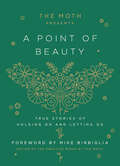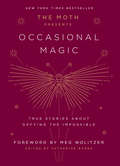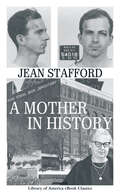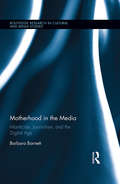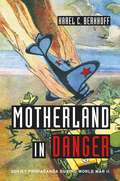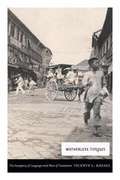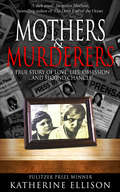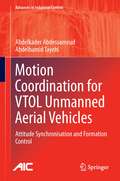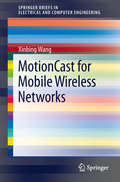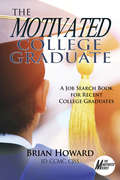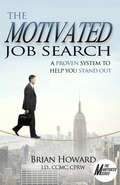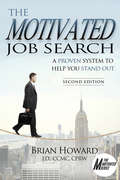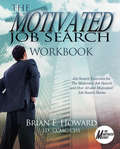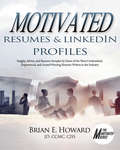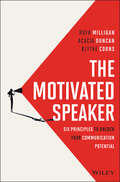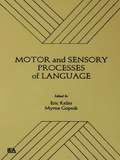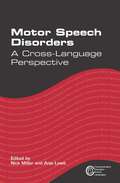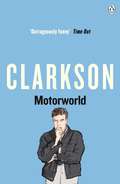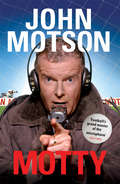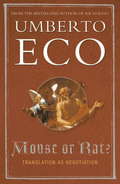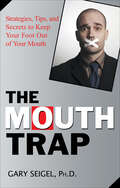- Table View
- List View
The Moth Presents: True Stories of Holding On and Letting Go (The Moth Presents)
by The Moth Mike BirbigliaAn inspiring and entertaining collection of unforgettable true stories about finding unexpected beauty in life&’s transitions—from Lin-Manuel Miranda, Elizabeth Gilbert, Quiara Alegría Hudes, and many more. &“The Moth taught me how to be vulnerable, how to take my time, and how to listen to someone else&’s story and share in their moments of triumph, laughter, or, yes, sometimes embarrassment with an open heart.&”—Mike Birbiglia, from the Foreword An international rescue mission for Paddington Bear. A family matriarch running numbers in Detroit. An epic Lucha Libre showdown in Mexico City. A beach vacation spent looking for the Kennedys. Storytellers from around the world share times they found real beauty in the moments when their lives changed forever—for better or for worse. Carefully selected by the creative minds at The Moth and adapted to the page to preserve the raw energy of stories told live, on stage, and without notes, A Point of Beauty features voices familiar and new. This collection offers a shared message: If we look closely enough, we can find power in strengthening frayed bonds but also in having the courage to walk away from things that no longer feed our spirit. Through these storytellers&’ passion and their hope, they teach us all about what&’s worth holding on to: our relationships with those we love the most, our understanding of ourselves, and—of course—gathering together to tell and listen to our stories.
The Moth Presents: True Stories About Defying the Impossible (The Moth Presents #2)
by Meg Wolitzer Catherine BurnsNEW YORK TIMES BESTSELLER • From storytelling phenomenon and hit podcast The Moth—and featuring contributions from Meg Wolitzer, Adam Gopnik, Krista Tippett, Andrew Solomon, Rosanne Cash, Ophira Eisenberg, Wang Ping, and more—a new collection of unforgettable true stories about finding the strength to face the impossible, drawn from the very best ever told on its stagesCarefully selected by the creative minds at storytelling phenomenon The Moth, and adapted to the page to preserve the raw energy of stories told live, onstage and without notes, Occasional Magic features voices familiar and new. Inside, storytellers from around the world share times when, in the face of seemingly impossible situations, they found moments of beauty, wonder, and clarity that shed light on their lives and helped them find a path forward. From a fifteen-year-old saving a life in Chicago to a mother of triplets trekking to the North Pole to a ninety-year-old Russian man recalling his standoff with the KGB, these storytellers attest to the variety and richness of the human experience, and the shared threads that connect us all. With honesty and humor, they stare down their fear, embrace uncertainty, and encourage us all to be more authentic, vulnerable, and alive.
A Mother in History
by Jean StaffordJean Stafford's unforgettable portrait of Marguerite Oswald, the mother of Lee Harvey Oswald.Curious about &“the influences and accidents and loves and antipathies and idiosyncrasies&” that shaped Lee Harvey Oswald, the novelist and short story writer Jean Stafford spent nine hours interviewing Marguerite Oswald in May 1965. A Mother in History (1966) is the acerbic result, an indelible portrait of a woman hungry for money, fame, and attention, full of righteous self-pity, and relentless in professing her son&’s blamelessness: &“Killing does not necessarily mean badness. You find killing in some very fine homes for one reason or another.&” Stafford&’s controversial profile elicited mixed reviews—Newsweek praised it as a &“masterpiece of character study,&” while Time called it &“the most abrasively unpleasant book in recent years&”—and angry readers accused her of seeking to &“enthrone a wicked woman&” and &“demolish the sacred throne of motherhood.&” It captures a moment in history when the trauma of Dallas was still raw, Lee Harvey Oswald&’s guilt was widely accepted, and Marguerite Oswald, with her obsessive &“research&” into hidden &“truths&” and the machinations of an omnipresent &“they,&” appeared to be a singular prisoner of maternal delusion, and not a harbinger of the decades to come.
Motherhood in the Media: Infanticide, Journalism, and the Digital Age (Routledge Research in Cultural and Media Studies)
by Barbara BarnettThis book examines contemporary media stories about women who kill their children. By analyzing media texts, motherhood blogs, and journalistic interviews, the book seeks to understand better maternal violence and the factors that lead women to harm their children. The central thesis of this book is that media practices have changed dramatically during the past 50 years, as has society’s views on "appropriate" feminine behavior, yet definitions of characteristics of good mothers remain largely defined by 1950s sit coms, Victorian ideals, and Christian theology. The book contends that in spite of media saturation in American society, and the media’s increased opportunities to tell complex and nuanced stories, news media narratives continue to situate maternal violence as rare, unfathomable, and unpredictable. The news media’s shift in focus—from public service to profit-making industry—has encouraged superficial coverage of maternal violence as reporters look for stories that sell, not stories that explain. Motherhood blogs, in contrast, offer an opportunity for women to tell their own stories about motherhood, based on experience. Interviews with journalists offer insights into how the structure of their jobs dictates media coverage of this intimate form of violence.
Motherland in Danger
by Karel C. BerkhoffMuch of the story about the Soviet Union’s victory over Nazi Germany has yet to be told. In Motherland in Danger, Karel Berkhoff addresses one of the most neglected questions facing historians of the Second World War: how did the Soviet leadership sell the campaign against the Germans to the people on the home front? For Stalin, the obstacles were manifold. Repelling the German invasion would require a mobilization so large that it would test the limits of the Soviet state. Could the UR marshal the manpower necessary to face the threat? How could the authorities overcome inadequate infrastructure and supplies? Might Stalin’s regime fail to survive a sustained conflict with the Germans? Motherland in Danger takes us inside the Stalinist state to witness, from up close, its propaganda machine. Using sources in many languages, including memoirs and documents of the Soviet censor, Berkhoff explores how the Soviet media reflected-and distorted-every aspect of the war, from the successes and blunders on the front lines to the institution of forced labor on farm fields and factory floors. He also details the media’s handling of Nazi atrocities and the Holocaust, as well as its stinting treatment of the Allies, particularly the United States, the UK, and Poland. Berkhoff demonstrates not only that propaganda was critical to the Soviet war effort but also that it has colored perceptions of the war to the present day, both inside and outside of Russia.
Motherless Tongues: The Insurgency of Language amid Wars of Translation
by Vicente L. RafaelIn Motherless Tongues, Vicente L. Rafael examines the vexed relationship between language and history gleaned from the workings of translation in the Philippines, the United States, and beyond. Moving across a range of colonial and postcolonial settings, he demonstrates translation's agency in the making and understanding of events. These include nationalist efforts to vernacularize politics, U.S. projects to weaponize languages in wartime, and autobiographical attempts by area studies scholars to translate the otherness of their lives amid the Cold War. In all cases, translation is at war with itself, generating divergent effects. It deploys as well as distorts American English in counterinsurgency and colonial education, for example, just as it re-articulates European notions of sovereignty among Filipino revolutionaries in the nineteenth century and spurs the circulation of text messages in a civilian-driven coup in the twenty-first. Along the way, Rafael delineates the untranslatable that inheres in every act of translation, asking about the politics and ethics of uneven linguistic and semiotic exchanges. Mapping those moments where translation and historical imagination give rise to one another, Motherless Tongues shows how translation, in unleashing the insurgency of language, simultaneously sustains and subverts regimes of knowledge and relations of power.
Mothers & Murderers: A True Story of Love, Lies, Obsession . . . And Second Chances
by Katherine Ellison&“[Weaves] together her own story and a stranger-than-fiction true-crime tale…gripping prose that by turns is tragic and hilarious.&”—Stephen Hinshaw, author of Another Kind of Madness This remarkable memoir by a Pulitzer Prize- and Polk Award-winning journalist takes readers on a wild, tragicomic ride from the criminal courtrooms of California&’s Silicon Valley to the Himalayan mountains of Pakistan to the deserts of Ethiopia. In delightful, insightful prose, Katherine Ellison reflects on her mistakes and her triumphs as she reveals the stories of how her career almost ended before it began, how she nearly missed marrying the love of her life, and how she unwittingly got drawn into a bizarre murder case. Rich in drama and self-reflection, replete with unique characters—including two bumbling hitmen, a rodeo-riding prosecutor, a flamboyant Beverly Hills defense attorney, and a charismatic stay-at-home mother-of-three who is keeping outrageous secrets—Mothers & Murderers is like a mashup of Fargo and Eat, Pray, Love—a memoir to make you laugh, cry, and think. &“In what she&’s authentically dubbed a &‘true-crime memoir, Katherine Ellison brings to bear the demons of her own past, her considerable chops as a reporter, and her willingness to plunge into the psychological depths. What she created is a dark jewel. The reader cannot look away.&”—Jacquelyn Mitchard, New YorkTimes-bestselling author of The Deep End of the Ocean &“Mothers and Murderers is like nothing else I&’ve ever read, and I mean that in the best possible way…Katherine Ellison captivatingly describes a young woman's path from blind impulse to wisdom…she makes an ultra-strong case for the examined life, shedding light on the lies we tell ourselves and others—and the hard work involved in taking responsibility for yourself.&”—Stephen Hinshaw, author of Another Kind of Madness
Motion Coordination for VTOL Unmanned Aerial Vehicles: Attitude Synchronisation and Formation Control
by Abdelhamid Tayebi Abdelkader AbdessameudMotion Coordination for VTOL Unmanned Aerial Vehicles develops new control design techniques for the distributed coordination of a team of autonomous unmanned aerial vehicles. In particular, it provides new control design approaches for the attitude synchronization of a formation of rigid body systems. In addition, by integrating new control design techniques with some concepts from nonlinear control theory and multi-agent systems, it presents a new theoretical framework for the formation control of a class of under-actuated aerial vehicles capable of vertical take-off and landing. Several practical problems related to the systems' inputs, states measurements, and restrictions on the interconnection topology between the aerial vehicles in the team are addressed. Worked examples with sufficient details and simulation results are provided to illustrate the applicability and effectiveness of the theoretical results discussed in the book. The material presented is primarily intended for researchers and industrial engineers from robotics, control engineering and aerospace communities. It also serves as a complementary reading for graduate students involved in research related to flying robotics, aerospace, control of under-actuated systems, and nonlinear control theory
MotionCast for Mobile Wireless Networks
by Xinbing WangMotionCast for Mobile Wireless Networks provides an overview on the research for mobile ad-hoc networks regarding capacity and connectivity. Wireless ad-hoc networks are useful when there is a lack of infrastructure for communication. The proposed notion "MotionCast" is for the capacity analysis of multicast in MANET. A new kind of connectivity (k;m)-connectivity, is also defined, and its critical transmission range for i.i.d. (independently and identically distributed) and random walk mobility models are derived respectively. This book also investigates the related issues of connectivity in mobile and static circumstances. In addition, it provides a survey of the capacity scaling research, which gives a good summary of this field.
The Motivated College Graduate: A Job Search Book for Recent College Graduates (Motivated Series #6)
by Brian E. HowardBook Six in Motivated Series by Brian E. Howard.There are over 120 pieces of sage advice quoted throughout the book on how to effectively conduct a job search, write a powerful resume and LinkedIn profile,cover letters, and other communications.The Motivated College Graduate is the most comprehensive job search book written for the recent college graduate. It discusses real life job search issues facing today's college graduate. The book provides unprecedented insight and advice from some of the most credentialed and experienced career coaches and resume writers in the industry. These coaches and resume writers have specialized practices and work with recent college graduates. You will learn how to conduct an effective job search, stand out among your competition, get interviews, and job offers!Go inside the minds of these coaches and resume writers. Learn how they've coached other college graduates to land fulfilling career-level positions. Understand how the resume writers think about keywords, titling, branding, accomplishments, color, design, and a plethora of other resume writing considerations as they create winning resumes.Based on his extensive experience in the job search industry and by tapping into the collective knowledge of career coaches and resume writers who work specifically with college graduates, Brian Howard has written a comprehensive job search book that surpasses all other job search books written for the recent college graduate.
The Motivated Job Search: A Proven System to Help You Stand Out (The Motivated Series)
by Brian E. Howard<p><i>The Motivated Job Search</i> is a practical no-nonsense guide to getting the job offers you want in the shortest time possible! Brian Howard provides as proven and systematic approach for conducting a real-world job search based on years of front line recruiting experience helping thousands of job seekers find hidden job market openings, acing interviews, and winning job offers! <p><i>The Motivated Job Search</i> gives you a distinctive competitive edge by teaching time-tested and proven techniques that will make you stand out from other job seekers. <i>The Motivated Job Search</i> covers meaningful topics like how to correctly prepare for a job search, profiling your next job, understanding the employer's mind, branding, elevator speech, success stories, LinkedIn, networking, social media, the hidden job market, interviewing along with a myriad of useful job search tools not otherwise written about in other job search books. <p><i>The Motivated Job Search</i> promotes a self-motivated job search approach where you take charge by proactively engaging the job market in various ways to discover opportunities. The self-motivated approach teaches impactful ways to engage employers that leads to interviews resulting in job offers!<p>
The Motivated Job Search: A Proven Method to Help You Stand Out (Motivated Ser. #6)
by Brian E. HowardThe Motivated Job Search, Second Edition is a practical no-nonense guide to getting the job offers you want in the shortest time possible? Brian Howard provides a proven and systematic approach for conducting a real-world job search based on years of recruiting experience helping thousands of job seekers find hidden job market openings, acing interviews, and winning job offers! The book provides the informational steps to conduct a job search, but more importantly the strategic insight from someone who is actively engated in front line recruiting. These strategic insights include the use of: the "psychology of persuasion" throughout your job search, understanding the mind and motivations of an employer, maximizing the use of accomplishments, optimizing your LinkedIn profile by leveraging the algorithms and programming to your advantage, the strategic options regarding your LinkedIn profile if you are unemployed, a whole new way to view your networking efforts, how to handle interviewing for maximum sucess, six unique tactics that will create differentiation from other job seekers, and job offer negotiations using the WITS Approach TM , among others. The Motivated Job Search, Second Edition will give you a distinctive competitive edge by teaching time-tested and proven techniques from a field expert that will make you stand out from other job seekers, resulting in job offers!
The Motivated Job Search Workbook: Exercises for The Motivated Job Search and Over 50 and Motivated Job Search Books (The Motivated Series #4)
by Brian E. HowardJob search expert, Brian E. Howard, has been helping job seekers for over 25 years. From that depth of experience, Brian wrote The Motivated Job Search Workbook, which contains thought-provoking questions and exercises that correlate directly with Brian's job search books: The Motivated Job Search and Over 50 and Motivated! Conducting a job search can be a daunting task, especially if that job search was put upon you unexpectedly. Thoughts and questions like where to start, what to do, how to deal with feelings, and where to go for information, among so many others, can quickly overwhelm you and deflate your confidence. This workbook, used with The Motivated Job Search or Over 50 and Motivated! will get you through it! It will lead you to your next job! With plenty of writing space, The Motivated Job Search Workbook, takes you through the step-by-step process of a motivated job search. The questions and exercises are simple but will make you think about yourself, your professional value proposition, your successes, your brand, and all of the practical action items you must do to successfully execute a job search. Written as a comprehensive workbook for the entire job search process, it will keep you organized, keep you thinking, and keep you motivated!
Motivated Resumes and LinkedIn Profiles: Insight, Advice, and Resume Samples Provided by Some of the Most Credentialed, Experienced, and Award-Winning Resume Writers in the Industry (The Motivated Series #5)
by Brian E. Howard<i>Motivated Resumes and LinkedIn Profiles</i> is unlike any resume or LinkedIn profile book ever written! It gives you unprecedented insight and advice from over a dozen of the most credentialed, experienced, and award-winning resume and LinkedIn profile writers in the industry. <p>It contains over 180 pieces of sage advice quoted throughout the book. You will learn how these writers create impactful resumes and LinkedIn profiles that will stand out, get you interviews, and job offers! Get inside the minds of these writers. Learn how they think about keywords, titling, branding, accomplishments, format, color, design, and a host of other resume writing and LinkedIn profile considerations as they create stunning resumes and winning LinkedIn profiles. <p>Some say that <i>Motivated Resumes and LinkedIn Profiles</i> reveals too many secrets of the resume writing industry! Become an “insider” and learn the secrets from some of the very best.</p>
The Motivated Speaker: Six Principles to Unlock your Communication Potential
by Ruth Milligan Acacia Duncan Blythe CoonsMaster the mindsets and practices of the world's best public speakers A team of veteran communication and speaking coaches delivers a groundbreaking new framework to becoming a great communicator. Thanks to the authors' decades of experience, readers will discover the six essential threshold concepts needed to give talks like the best TED speakers and Fortune 500 leaders. Their practical and accessible approach will help you establish powerful habits in your speaking practice. You'll understand what's preventing you from being influential and persuasive, and build a new foundation toward being a highly effective communicator. This trailblazing book goes beyond cliches like “overcome your fear” and obvious advice like “don't read your speech.” It dives deep into the transformative, integrative, and challenging ideas that will enable you to level up your speaking. Included here are: Deep explanations of what it takes to become an effective communicator Insights into the dispositions, behaviors, and skills that great speakers consistently demonstrate and how to develop them in yourself Expert guidance on how to use the latest technologies to augment your public speaking development A comprehensive framework for learning public speaking, The Motivated Speaker is the perfect resource for working professionals and leaders who want to learn to speak persuasively, confidently, clearly, and compellingly.
Motor and Sensory Processes of Language (Neuropsychology and Neurolinguistics Series)
by Eric Keller Myrna GopnikPublished in 1987, Motor and Sensory Processes of Language is a valuable contribution to the field of Cognitive Psychology.
Motor Speech Disorders
by Anja Lowit Nick MillerMotor speech disorders are a common accompaniment of a whole range of neurological conditions, from stroke, brain injury and Parkinson's disease through to many rarer conditions. This book aims to aid understanding of the nature of motor speech disorders from a cross-language perspective, in contrast to the largely English-centric nature of research and practice recommendations to date. The book looks not just at how these motor speech disorders are assessed and treated in other countries, but also examines how underlying speech impairments differ according to the language someone speaks. The book studies the underlying neurological, neurophysiological and neurophonetic characteristics of motor speech disorders in different language contexts, and discusses the implications these have for clinical rehabilitation. This significantly adds to debates around the theoretical understanding and clinical management of motor speech disorders.
Motorworld
by Jeremy ClarksonJeremy Clarkson invites us to Motorworld, his take on different cultures and the cars that they drive.There are ways and means of getting about that don't involve four wheels, but in this slice of vintage Clarkson, Jeremy isn't much interested in them.Back in 1996, he took himself off to twelve countries (okay, eleven - he goes to America twice) in search of the hows, whys and wherefores of different nationalities and their relationships with cars. There were a few questions he needed answers to:* Why, for instance, is it that Italians are more interested in looking good than looking where they are going?* Why do Indians crash a lot?* How can an Arab describe himself as 'not a rich man' with four of the world's most expensive cars in his drive? * And why have the otherwise neutral Swiss declared war on the car?From Cuba to Iceland, Australia to Vietnam, Japan to Texas, Jeremy Clarkson tells us of his adventures on and off four wheels as he seeks to discover just what it is that makes our motorworld tick over. _____________Praise for Jeremy Clarkson:'Brilliant . . . laugh-out-loud' Daily Telegraph'Outrageously funny . . . will have you in stitches' Time Out'Very funny . . . I cracked up laughing on the tube' Evening Standard
Motty: Forty Years in the Commentary Box
by John MotsonFrom Ronnie Radford to Wayne Rooney, John Motson's knowledge and passion for football are unrivalled. In Motty, he shares his story for the first time and guides us through a career which has spanned forty years and over 2,000 matches. From reporting on the exploits of the giant-killing Hereford team in the 1972 FA Cup that made his name on Match of the Day, to the estimated twenty-million viewers who tuned in to his commentary on England's match with Portugal at the 2006 World Cup, Motson's time in the commentary box has delivered some unforgettable anecdotes. In dozens of fascinating behind-the-scenes stories, we hear about the greatest football matches he has watched and the greatest players and managers he has been privileged to know. Many of them are football icons; Bill Shankly, Alex Ferguson, Brian Clough, Alf Ramsey, and Matt Busby, amongst countless others.Motty is essential reading for anyone who has grown up with the undisputed voice of football.
Mouse or Rat?: Translation as Negotiation
by Prof Umberto EcoFrom the world-famous author of THE NAME OF THE ROSE, an illuminating and humorous study on the pleasures and pitfalls of translation.'Translation is always a shift, not between two languages but between two cultures. A translator must take into account rules that are not strictly linguistic but, broadly speaking, cultural.'Umberto Eco is of the world's most brilliant and entertaining writers on literature and language. In this accessible and dazzling study, he turns his eye on the subject of translations and the problems the differences between cultures can cause. The book is full of little gems about mistranslations and misunderstandings.For example when you put 'Studies in the logic of Charles Sanders Peirce' through an internet translation machine, it becomes 'Studies in the logic of the Charles of sandpaper grinding machines Peirce'. In Italian 'ratto' has no connotation of 'contemptible person' but denotes speed ('you dirty rat' could take on a whole new meaning!)What could be a weighty subject is never dull, fired by Eco's immense wit and erudition, providing an entertaining read that illuminates the process of negotiation that all translators must make.
Mouse or Rat?: Translation As Negotiation
by Umberto Eco'Translation is always a shift,not between two languages but between two cultures. A translator must take into account rules that are not strictly linguistic but, broadly speaking, cultural.' Umberto Eco is of the world's most brilliant and entertaining writers on literature and language. In this accessible and dazzling study, he turns his eye on the subject of translations and the problems the differences between cultures can cause. The book is full of little gems about mistranslations and misunderstandings.For example when you put 'Studies in the logic of Charles Sanders Peirce' through an internet translation machine, it becomes 'Studies in the logic of the Charles of sandpaper grinding machines Peirce'. In Italian 'ratto' has no connotation of 'contemptible person' but denotes speed ('you dirty rat' could take on a whole new meaning!) What could be a weighty subject is never dull, fired by Eco's immense wit and erudition, providing an entertaining read that illuminates the process of negotation that all translators must make.
The Mouth Trap: Strategies, Tips, and Secrets to Keep Your Foot Out of Your Mouth
by Gary SeigelIf you’ve ever had a conversation that you wished you’d handled differently, this book is for you!We all know the feeling of cringing and thinking “Me and my big mouth.” Or feeling exhausted and frustrated after a long, pointless argument—the same one you’ve had over and over. Communication can be tricky, especially with difficult people—but this book provides a better way to handle conversational challenges both tactfully and effectively. The Mouth Trap will show you how to deliver a message and achieve the outcome you desire every time you speak. Learn to:• Develop the confidence to repair mistakes, apologize, and create peace• Become adept at responding right the first time• Navigate smoothly around difficult people at work, and moreFrom a nationwide speaker whose clients have ranged from the US Navy to the International House of Pancakes, The Mouth Trap is filled with entertaining, real-life examples of conflicts and awkward conversations—and smart ways to smooth them over.
Move On: Adventures in the Real World
by Linda EllerbeeEllerbee gives details on how she moved from working with ABC to CNN.
A Moveable Feast (Virago Modern Classics)
by Ernest HemingwayErnest Hemingway's classic memoir of Paris in the 1920s, now available in a restored edition, includes the original manuscript along with insightful recollections and unfinished sketches.Published posthumously in 1964, A Moveable Feast remains one of Ernest Hemingway's most enduring works. Since Hemingway's personal papers were released in 1979, scholars have examined the changes made to the text before publication. Now, this special restored edition presents the original manuscript as the author prepared it to be published. Featuring a personal Foreword by Patrick Hemingway, Ernest's sole surviving son, and an Introduction by grandson of the author, Seán Hemingway, editor of this edition, the book also includes a number of unfinished, never-before-published Paris sketches revealing experiences that Hemingway had with his son, Jack, and his first wife Hadley. Also included are irreverent portraits of literary luminaries, such as F. Scott Fitzgerald and Ford Maddox Ford, and insightful recollections of Hemingway's own early experiments with his craft. Widely celebrated and debated by critics and readers everywhere, the restored edition of A Moveable Feast brilliantly evokes the exuberant mood of Paris after World War I and the unbridled creativity and unquenchable enthusiasm that Hemingway himself epitomized.
Movement for Actors
by Nicole PotterTeachers and practitioners offer actors, directors, and students both practical suggestions and inspiration on how to tell the story through the body. Body basics, beyond glove and fan, and schools of thought are among the themes.
